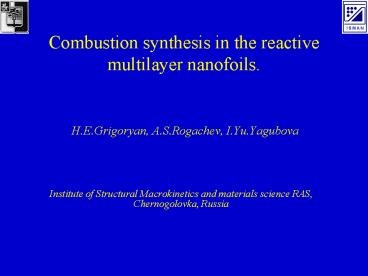Combustion synthesis in the reactive multilayer nanofoils. - PowerPoint PPT Presentation
1 / 38
Title:
Combustion synthesis in the reactive multilayer nanofoils.
Description:
Microstructure of foils. ? fracture, SEI; b surface of the foil, atomic scanning tunneling microscopy. Cross-section of the Ti/Al ... – PowerPoint PPT presentation
Number of Views:141
Avg rating:3.0/5.0
Title: Combustion synthesis in the reactive multilayer nanofoils.
1
Combustion synthesis in the reactive multilayer
nanofoils.
- H.E.Grigoryan, A.S.Rogachev, I.Yu.Yagubova
- Institute of Structural Macrokinetics and
materials science RAS, Chernogolovka, Russia
2
The scheme of production of multilayer nano-foils
100-4000 layers 5-1000 nm thickness
3
Microstructure of foils
? fracture, SEI b surface of the foil,
atomic scanning tunneling microscopy.
4
Cross-section of the Ti/Al multilayer film
100 nm
TEM
SEM
1000 nm
5
Surface of multilayer film Ti/Al
(Atomic Scanning Tunneling Microscopy)
1 micron
6
(No Transcript)
7
Main features of the multilayer nanofilm structure
- Continuous layers can be formed with thickness
from 4 to 1000 nm - Column lamellar grains appear in all samples
- Multilayer systems possess very attractive
structure for the study of mechanisms of chemical
reactions in micro- and nano-heterogeneous systems
Layer boundary
Grain boundary
Close-packed atom planes
8
The scheme of experiment
1- sample, 2 mica holder, 3 thin wire, 4
molybdenum heater, 5 steel junction, 6 power
supply, 7 - semiconductor relay, 8 - storage
battery, 9 pulsed-controled oscillator, 10 -
lighter, 11 thermocouple, 12 temperature
registration, 13 - window, 14 vacuum chamber,
15 high-speed video-recorder, 16
photodiode, 17 differential amplifier, 18
PC.
9
Experimental setup
10
Combustion of Ti/Al multilayer foil Steady mode
T0 200 0?
11
Combustion of Ti/Al multilayer foil Non-steady
mode
T0 20 0?
12
Combustion of Ti/3Al MLF Spinning combustion
T0 20 0?
13
Evidence of oscillating combustion in MLNF Ti/3Al
14
Instantaneous velocity for different combustion
modes
15
The effect of initial temperature to velocity and
combustion mode
16
Temperature profiles of steady and non-steady
combustion wave
17
Dependence of combustion velocity on initial
temperature, for different foils and different
type of ignition
1-6 ignition by thin wire 7-11 ignition by
spark 12 literature data for TiAl powder
mixtures Composition TiAl 1 - 2200 layers -
9 nm 2 - 2200 layers - 14 nm 3 - 1350 layers
- 9 nm 4 - 1350 layers - 14 nm 5 - 300 layers
- 70 nm 6 and 10 - 4700 layers 6 nm, 7 - 300
layers 50 nm 8 - 775 layers - 20 nm, 9 - 1350
layers - 9 ??. Composition Ti3Al 11 - 300
layers 60 nm.
18
Some features of SHS in the MLNF Ti/Al
Combustion velocity as a function of thickness of
the layers
19
Quenched combustion wave in the Ti/3Al MNF
U
20
In situ TEM study of heterogeneous reaction and
TiAl product formation
T 600 K
T 700 K
T 900 K
T 1100 K
21
Detailed microstructure of reacting Ti/Al MNF
(in situ TEM)
T 1100 K
100 nm
22
Laboratoire pour lUtilisation du Rayonnement
Electromagnetique
23
Gasless combustion of multilayer nanofilm Ti/Al
(T0420 K)
TiAl(111)
Ti(002)
Ti3Al(?)
TiAl(202)
Al(220)
TiAl(220)
24
Gasless combustion of multilayer nanofilm Ti/3Al
TiAl(111)
Ti(002)
TiAl(202)
TiAl(220)
Al(220)
TiAl3(?)
25
Phase transformation in multilayer nanofoils
during combustion (part)
Ti/Al
Ti/3Al
26
Budker Institute of Nuclear Physics(Novosibirsk
)
27
Gasless combustion of multilayer nanofilm Ti/3Al
(time resolution 1ms)
28
Scheme of TRSRD experiment
29
Structural transformations in multilayer foil
Ti/Al during slow heating (T570 K)
I
II
III
TiAl(111)
Ti(002)
Al(220)
30
Structural transformations in multilayer foil
Ti/Al during slow heating (T570 K) stage I,
time step 2 sec
31
Structural transformations in multilayer foil
Ti/Al during slow heating (T570 K) stage II,
time step 8 sec
32
Thank you for attention!
33
Structural transformations in multilayer foil
Ti/Al during slow heating (T570 K) stage III,
time step 4 sec
34
Conclusions
- Distribution of local instant velocieties shows
that the instant value of the combustion
velocity in multilayer foil never drop down to
zero, as it frequently happens in powder mixres - Different kind of combustion waves were observed
- Combustion temperatures for different modes was
determined - The mechanism of formation of final product
phases, TiAl and TiAl3, in the reactive
multilayer films includes several stages,
starting from 550 K - Time-Resolved Synchrotron Radiation Diffraction
analysis combined with TEM and SEM can provide
detailed information about reaction routes in
micro-heterogeneous and nano-heterogeneous
systems - - The SHS process in the Ti-AL, Ti-3Al, Ni-Al
multilayer foils shows an example of the
quasi-homogeneous gasless comustion
35
Structure transformations in multilayer nanofoil
Ti/Al during slow heating (T570 K)
I
II
III
TiAl(111)
Ti(002)
Al(220)
36
Critical parameters(LURE)
- Wave-lenght 2,53 ? (4,9 KeV)
- monochromaticity 0,0004
- Intensity 1010 photon/sec
- diffracted area rectangle 0,1 ? 1,5 ??
37
Critical parameters(INP)
- Wave-lenght 1,54 ? (4,9 KeV)
- monochromaticity 0,0004
- Intensity 1013 photon/sec
- diffracted area rectangle 1 ? 10 ??
38
Coherency of atomic radii and crystal structures
Atom radius, A
Type of structure
Atomic number































